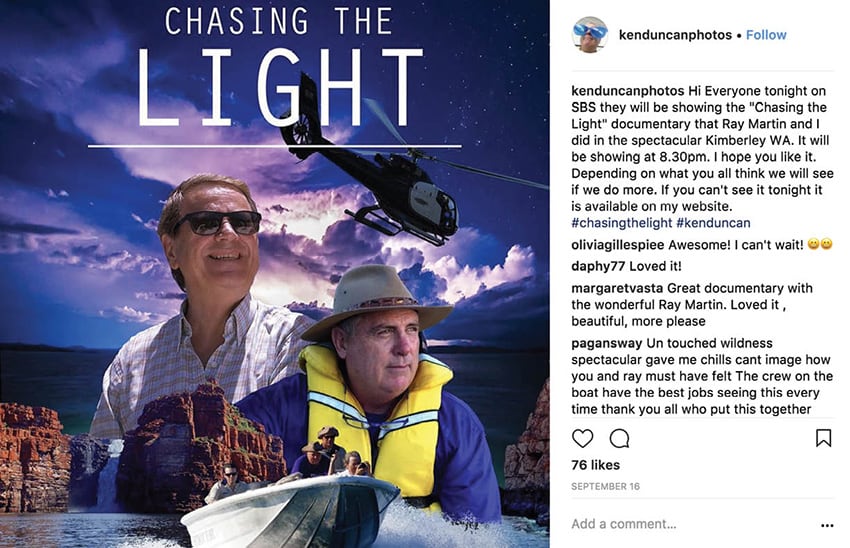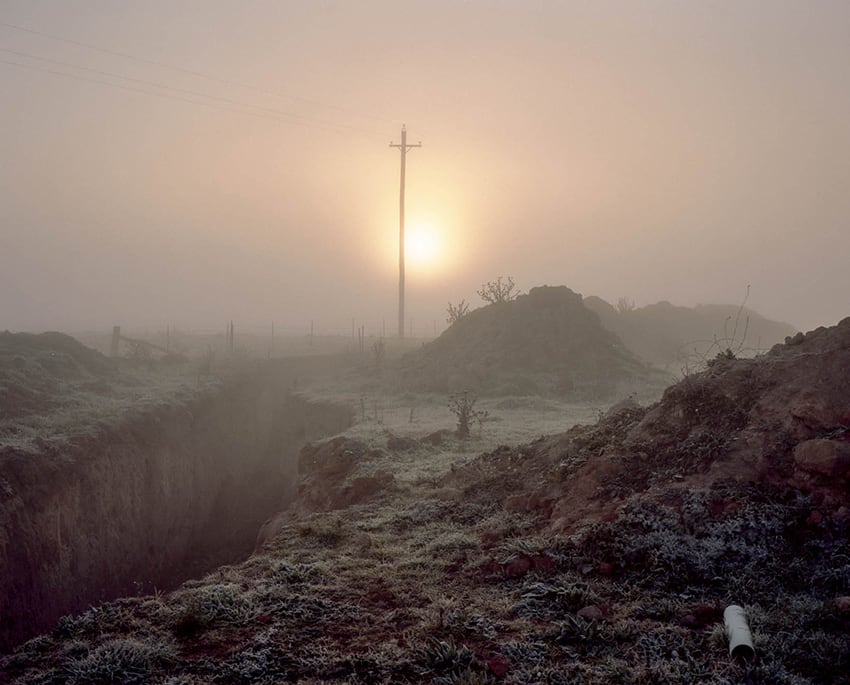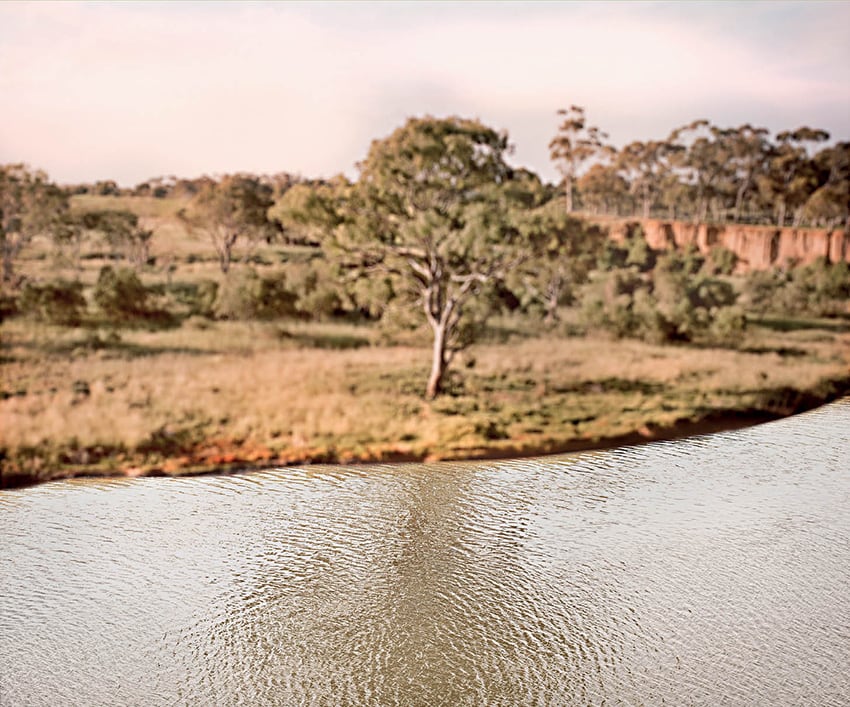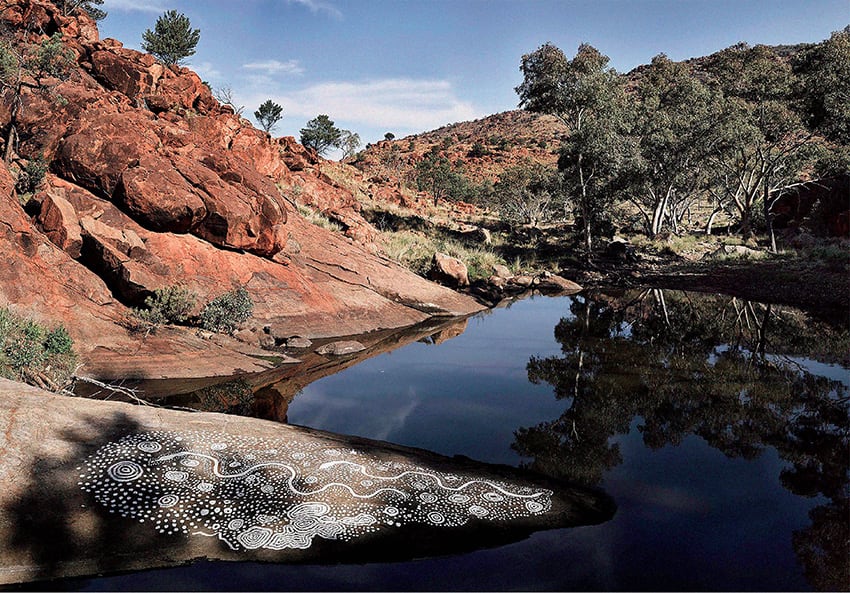A sunset over gentle oceans
~ Bondi Beach AwakeningTime-lapse shot of a waterfall
~ Caressing Waters (alternatively Majestic Beauty, or, Waters of Life)The still course of a waterway,
mirroring the bushland above
~ River ReflectionsUluru during a storm, at sunrise
~ Heartland RevivalPeople want peace in their lives and in their surroundings and nothing delivers as well as a classic Ken Duncan landscape
–Ken Duncan Group
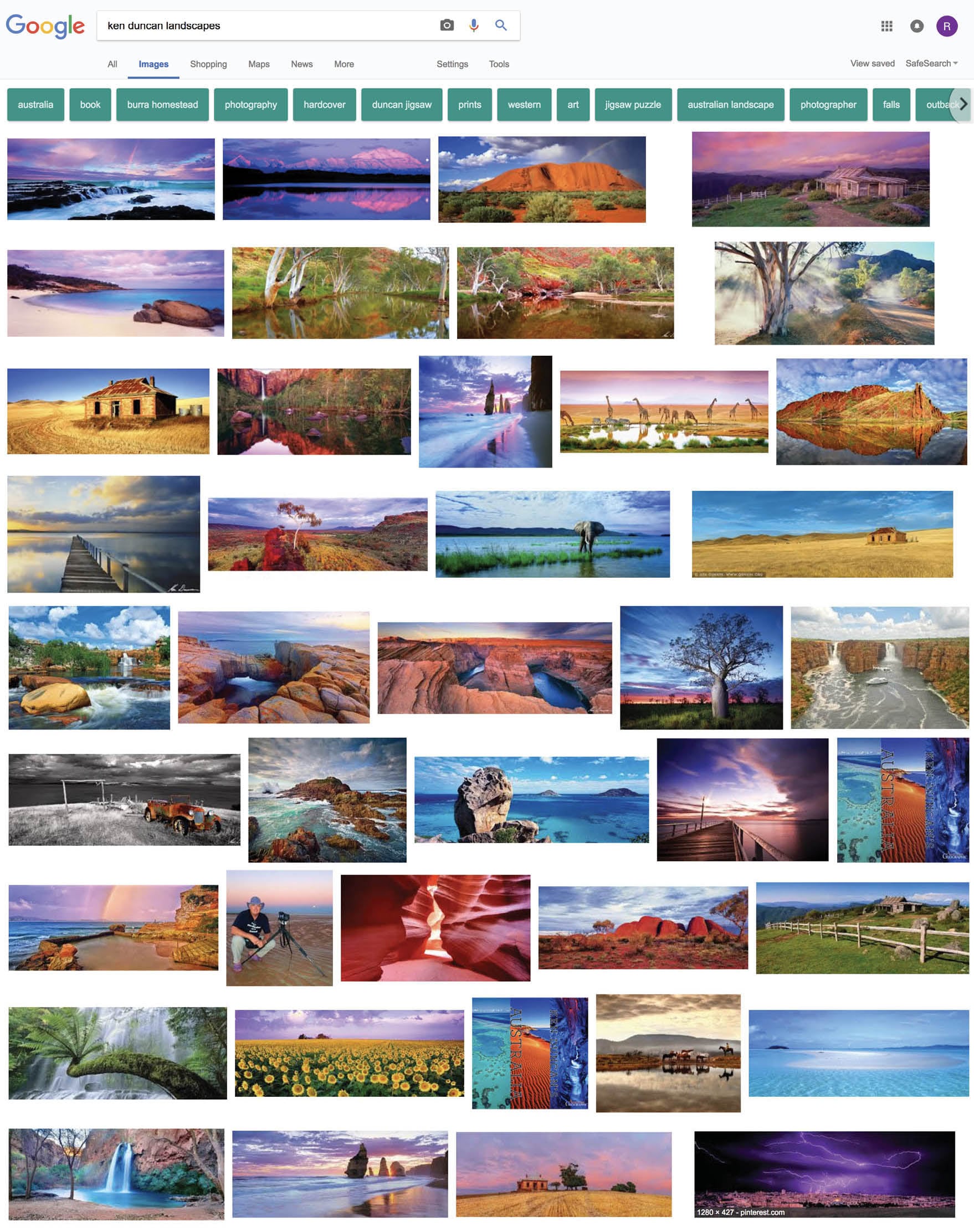
Landscape photography – along with landscape painting – has played an intrinsic role in the formation and imaging of national identity since the beginning of the Australian colonial project, and is central to how many modern day Australians see and define the country, and themselves. Images mentioned above such as Bondi Beach Awakening, or Majestic Beauty(Ken Duncan OAM, dates unavailable) depict in great detail representations of the ‘wild’ earth, water and sky of this country. Yet despite benefiting directly from the specifics of place, these photographs draw from a history linked to traditions of American photography and European painting, and aesthetic modes that have originated elsewhere — such as the sublime and the picturesque — ignoring the politics that play out within their own unique context.
At the same time, neo-colonial ventures seeking to profit off the sale of land, lifestyle and tourism directly benefit from the cliches of ‘untouched wilderness’ that fill our daily lives with depictions of landscapes on billboards, jigsaw puzzles, postcards, inspirational calendars and laminated posters. While this behaviour can be viewed as commercially driven, how does it reflect wider attitudes towards land use and value? Looking to the work of Ken Duncan OAM, a commercial photographer who has made his career through imaging land in this way, I unpick how such work negates multiple narratives of place, including histories of Indigenous land management and colonial violence. Furthermore, I ask what is the role — if there is one — that the photography of land can play in the decolonisation of attitudes to land and the specifics of place. These ideas will be fleshed out in reference to several contemporary artists, including James Tylor, Rosemary Laing, Wouter Van de Voorde, Peta Clancy and Tjungu Palya artists; unsettling the glossy campaigns of Tourism Australia and challenging notions of what Eurocentric concepts of ‘landscape’ entail.
Western tropes in non western place
Duncan, the self-described ‘pioneer of Limited Edition Photographic Art in Australia’, boasts a practice of over two hundred thousand published panoramic prints, over forty book publications, at least one documentary, an OAM, video clips for Midnight Oil, and a suite of high-profile awards. A white Australian with missionary parents, Duncan began his professional career in the 1980s. A biography available online through the Ken Duncan Group cites his initial drive with a desire to shoot parts of Australia not previously photographed and to ‘provide a feeling of the real “pioneer”’.1 His first book was published in 1987, titled The Last Frontier – Australia Wide (Weldon Publishing), just months before the Australian bicentenary in 1988. Over the years Duncan has released many other titles imaging constructs of the nation, including Spirit of Australia (1992), Ken Duncan’s Australia (2015) and Birth of a Nation (1995); a ‘historic, festive pictorial of The Rocks area in Sydney.’
Largely self-made, Ken Duncan OAM is highly successful within the commercial art market and through the Ken Duncan Group runs one of the largest privately owned photographic galleries in Australia. Commercially self-sufficient, Duncan manages to operate outside of mainstream contemporary fine art galleries and institutions and therefore largely avoid the critical rigour that comes with his level of success. His work emerged at a time when the photography of wilderness areas in Australia was becoming closely linked to the aims and public visibility of grassroots conservation campaigns, such as the Gordon-below-Franklin Dam, and the photography of Peter Dombrovskis.2 Profiting off ideas of natural beauty, Duncan’s images feed into and inform wider cultural discourses surrounding national identity and in particular, to conceptions of belonging and pride in place.
Typical Ken Duncan OAM images fit within what American writer Rebecca Solnit defines as ‘eco-porn’, whereby the image both exploits the land it photographs and creates unrealistic expectations of aesthetically pleasing or aestheticised landscapes. Solnit describes key signifiers of eco-porn images as containing; no reference to human presence or activity, no visible signs of natural history (such as death or decay), bright colours, lovable animals and references to the link between nature and Creation.3 Often Ken Duncan OAM photographs are composed in a picturesque manner, using a strong central horizon line and an arrangement of objects in the foreground that serve to anchor the image within a set perspective and scale. They borrow from colonial legacies of image-making that rely strongly on a fixed point of perspective, presenting the image as a window onto a field of Western spatial and temporal correlations, further encoding a rational and mediated view of the world.4 These scenic views perform a normalising function to an outsider, rendering unfamiliar scenes visibly manageable and containable. Many of Duncan’s images also reference the Romantic tradition of the sublime, whereby nature is treated or serves as a pleasurable and exotic place through which to travel and document. Therein, place is viewed from arms length rather than from the perspective of someone with an intimate and rooted knowledge in its specifics, and is often depicted as something to be overcome (see promotional image for Chasing the Light (2017), [Fig. 2] a documentary about Duncan’s quest for the perfect image in the Kimberley). Aesthetically Ducan’s images follow similar figurative techniques of composition and perspective to the sublime, presenting harmonious landscapes that are often reflective of internal moods or sentiments, both powerful and awesome and yet ready to be conquered.5
Like the images of Duncan, references to the sublime are present in the work of Canberra based, Belgian born, photographic artist Wouter Van de Voorde. Wouter’s aesthetic approach links back to the artist’s position as a Dutch migrant and outsider, a ‘photographer in exile’, and to his training in painting.6 One series in particular, titled Hume (sunrise), 2014, [Fig. 3] presents an interesting contrast in approach and intention to the work of Ken, and depicts landscapes, shot at sunrise, in the region of Hume. The otherworldly photographs play with emerging light, often cloaked through fog, in landscapes that bear the scars of Western society. Roads, power-lines and fence-lines demarcate space while introduced species, discarded belongings and industrial waste scatter his scenes and gesture to the human hand within spaces beyond the urban fringe. As with Ken’s work, light is used as a romantic and powerful signifer. However, the images do not signal in the same way to scenes of ‘wild’ ‘untamed’ land. Instead, the dramatic and ethereal use of light and shadow draws attention to forgotten or ‘ordinary’ environments, raising questions around preconceived notions of beauty of land. While Van de Voorde’s photographs do not necessarily serve to ‘decolonise’ the landscape per se, I would argue they are a potent example of the way photography can be used to challenge dominant narratives around representation of land, opening spaces to new audiences and reconsidering the value of places often overlooked.
Another artist whose landscapes are rooted in more traditional compositional frames is Brisbane born, Sydney based artist Rosemary Laing. Like Duncan, Laing has become known for her signature use of the panorama and for images that often hinge around the horizon line. However Laing uses her staged photographs to draw attention to histories of violence and displacement through interventions that are specific to place. As a non-Indigenous occupant, her work often questions arrival and attitudes of belonging and co-belonging in the landscape.7 In her recent photographic series Buddons (2017) layers of locally sourced second-hand cotton clothing cover and choke the course of an inland river on the south coast of New South Wales. The river depicted flows down to Wreck Bay, the site of multiple colonial ship disasters and deaths. Through her intervention, Laing makes visible human impact on the waterway, provoking questions of the people who have occupied and passed through the region and its multiple histories. Her choice of titles in the series ranges from the names of locally shipwrecked vessels (Rose of Australia), to shipwreck stories and rescues by Indigenous people (Wildflower), to paintings by Australian artists Grace Cossington Smith and Margaret Preston (Drapery and Wattle, Still-life with Teapot and Daisies). Relying on the disjunction drawn from their staged compositions these images differ from Duncan’s through the narrative questions they present and provoke.
Narrative & Intervention in Landscape
Landscapes hold histories. Formed as much by natural forces as by the human knowledge that encompasses them, they are continuously in flux, being at the whim of both natural disasters and changing knowledges, attitudes and values. In Australia — as great swathes of the country have been fenced, extracted, felled, concreted and polluted — ecocide has been committed by settlers to environments that have long histories of effective farming and management by Indigenous nations. It is a distinctly modernist view to see the environment as something to document, overcome, control and settle, and the suppression of histories of Indigenous land management can be seen to fit well within the colonising frame.8 To view the Australian bush solely as a place of wildness and wilderness ignores the histories and realities of western, modernist intervention.
At the same time narratives of pride and emotional sense of belonging within place are further strengthened and embodied when images of Uluru, or the Sydney Opera House, or the lone settlers hut are sold to us on placemats or personalised corporate products. Relying on popular legends, such as ‘the pioneer’ as methods of fostering self-legitimisation, such cliches draw from the idea that colonisers worked so hard to overcome adversity that they earned their place on Australian soil (or in the corporate office).9 This mythology plays into other common stereotypes of the outback — a place so unforgiving that only a real pioneer could take it on — or of ideas of wilderness mentioned above. To photograph a landscape within Australia that functions solely to celebrate its ‘untouched beauty’ is to continue practicing within the colonial mindset and to ignore histories of colonial invasion and occupation which have inevitably left their mark on the land. [Fig. 4]
There are numerous methods to approaching and addressing colonial legacies that can extend beyond the figurative scene. Bangerang artist Peta Clancy tackles these histories in her series Fissures in Time (2017) through images that have been physically broken and reconstructed. Shot over an extended period throughout the Victorian landscape, the images are informed by her own memories of place and from research into nineteenth century massacre sites in Victoria. To realise the project Clancy created large format photographs of landscapes, which were printed and partially dissected before being installed into custom mounts and rephotographed in situ. These second photographs were shot using the same composition, framing, and perspective; the dissected print serving as an intervention into its own image. What results are photographs that have been literally pieced together, reflecting true places but with visible inconsistencies in light and focus that have been formed through the artist’s relation to place over time. These inconsistencies do not lend themselves to a rational understanding of the landscape, instead they slow down the ‘reading’ of the image, encouraging the viewer to look twice and consider differences between the real and the perceived. Fissures in Time uses photography to physically scar the landscape, thereby disrupting narratives of aesthetic beauty and raising questions around preconceived ideas of place, its histories, and how these shift over time.
For James Tylor, as for Clancy, imaging landscape is an effective medium through which to critique colonisation and legacies of dispossession. Tylor, an artist of Nunga (Kaurna), Māori (Te Arawa) and European (English, Scottish, Irish, Dutch, Iberian and Norwegian) Australian descent intervenes in the image-making process by scarring the surface of the photograph, rather than the composition. In his 2016 series Territorial Encounters Tylor intervenes with the photographic medium to make visible histories of land removal along the South Australian coastline. Using the daguerreotype technique, a nineteenth century process whereby images are transferred onto silver copper plates, Tylor co-opts a photographic medium practiced at a time that frontier wars were occurring across the country. Based on areas of the South Australian coastline that were some of the last to be mapped by the British, his series of landscapes depict romanticised pastoral views that have been marked by deep fissures on the photographic surface.10 Creating a network of abstracted grids, these scars are reminiscent of map typographies, drawing to attention and echoing the ways in which land was divided and claimed after colonial encounters. Like Clancy, Tylor marks the landscape through violent, but mediated intervention, making visible colonial histories and challenging dominant representations of untouched country.
Place as worldview
‘White-fellas are seeing all our work on canvas but we want people to see the places that really are this dreaming.’
– Keith Stevens
Moving further from Eurocentric depictions of land, Indigenous conception and ownership of place are firmly presented by a group of senior artists working in the Anangu Pitjantjatjara Yankunytjatjara (APY) Lands of South Australia. Keith Stevens, Bernard Tjalkuri, Beryl Jimmy, Angkaliya Curtis and Marita Baker from Tjungu Palya art centre initiated the project Painting on Country in late 2016, which stands as a powerful testament of connection to place and culture. Completed on Country, the project saw the artists travel to their homelands with family members and paint their stories onto the landscape itself. The resulting series of large-scale images were documented by photographer Leopold Fiala, operating under the direction of the artists.11 Each painted landscape records and expresses culturally appropriate stories of each site’s Tjukurpa using the natural white pigment ‘tutu’, a material used ceremonially to paint the land and body, which have since been washed away by rain. Referencing both the ancient practices of rock art and contemporary western desert painting, Painting on Country functions not as reproduction but as an assertion of new traditions, melding ancient ideas with innovative artistic practice. Part photograph, part painting: absent of people yet full of their story, Painting on Country records a moment where distinctly Anangu worldviews shape and form the landscape image. [Fig. 5]
It is telling that our protocols around the photography of sacred sites or Country in Australia are barely existent. Conceptions of land since colonisation have been formed by repetitive imaging practices which have enacted and embedded cultural modes that solely benefit the coloniser, and render Indigenous presence and land use invisible (both historically and in the present day). European idealism and romantic religious sentiment have gushed forth artists such as Ken Duncan OAM, whose resplendent hyper-real photographs capture the ‘ideal’ vision of this country, neatly packaged for sale. The kind of visual culture that Ken Duncan OAM spearheads and which is reproduced on mass by many others serves to uphold visual elements of the fantasy sustaining the Australian colonial project. A landscape photography that could contribute to the decolonisation of attitudes to land and place would have to be considered within an expanded field of artistic and cultural production that negates the continued reproduction of colonial visuality and mythology. Important work is being produced by artists — both Indigenous and non-Indigenous — that prompts further conversations into different histories of land and meanings of place, and how they can be made visible. Co-opting European terms of reference to challenge traditional representations, as in the work of Wouter Van De Voorde and Rosemary Laing, or by physically working the photographic surface itself, as with James Tylor and Peta Clancy, photography begins to deform the rational and temporal spatialisations inherent in the colonial worldview. In the desert, artists working from Tjungu Palya have embodied their connection to Country by placing their presence firmly within the landscape frame; an antithesis to the myth of ‘untouched wilderness’. Alternate imaging practices such as these push the medium beyond Instagram marketing campaigns, revealing and reflecting on contemporary dialogues around land use, the specifics of place, and their histories.
Rebecca McCauley is an uninvited guest on unceded Wurundjeri and Boonwurung land who works with design, museums and photography, and is interested in the theoretical and practical intersections of these fields. Rebecca is particularly interested in how we form ideas of nature and wildness in an Australian, neo-colonial context that is increasingly shaped by human hands.
pp. 49-57.
2017, pp. 7-11.
Palya, SA, 2017.
